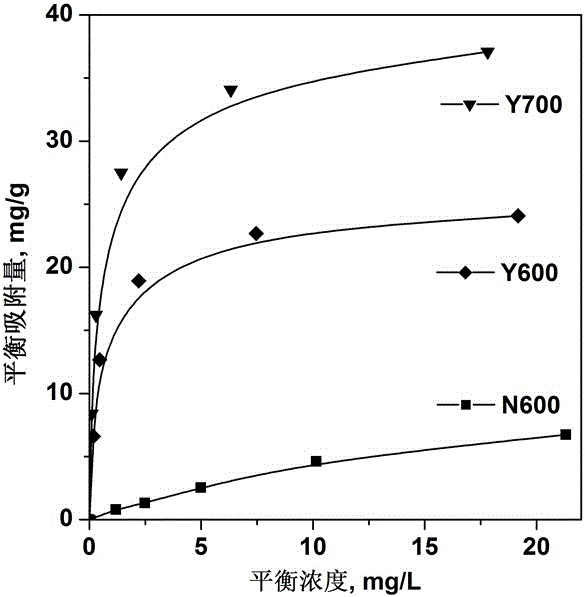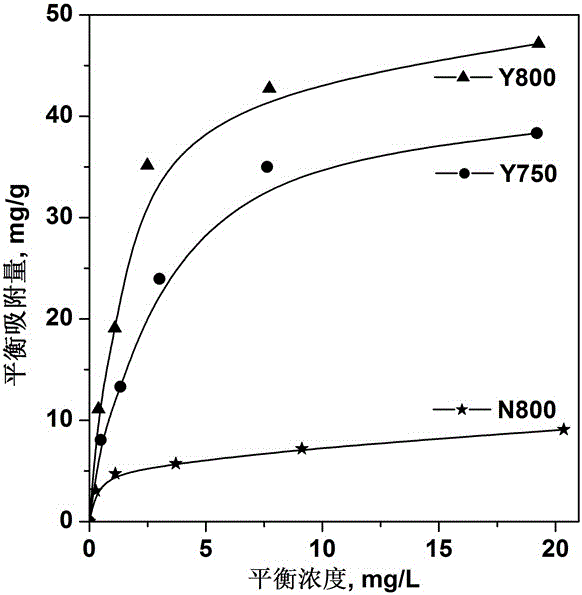Preparation method of biological carbon having high adsorption capacity to antibiotics
A technology of biochar and high adsorption, which is applied in the direction of biofuel, chemical instruments and methods, adsorption water/sewage treatment, etc., to achieve the effect of low cost, high reuse rate, and increased effective pore ratio
- Summary
- Abstract
- Description
- Claims
- Application Information
AI Technical Summary
Problems solved by technology
Method used
Image
Examples
Embodiment 1-8
[0024] Example 1-8: Effects of different pyrolysis atmospheres on the effective pore ratio of biochar using sawdust as raw material
[0025] Using sawdust as biomass raw material to compare different pyrolysis atmospheres, take 10g of sawdust, put it into a box-type pyrolysis furnace, and carry out pyrolysis in a mixed atmosphere of nitrogen and air. The pyrolysis temperature is 600°C, and the pyrolysis time is 6h. The obtained solid pyrolysis product was put into 60mL of hydrogen peroxide solution containing 5g of activated alumina balls (1-3mm in particle size) with a mass concentration of 15%. After stirring and mixing at room temperature for 8 hours, the activated alumina balls were taken out and the solid product was filtered out. , washed with water, and dried at 105°C to obtain a finished product. The specific surface area and pore structure of the prepared biochar sample were tested by a specific surface area and pore size analyzer. Refer to the general test method in ...
Embodiment 9-16
[0028] Examples 9-16: Effects of different pyrolysis atmospheres on the effective pore ratio of biochar using cow dung as raw material
[0029] Weigh 10g of cow dung as the biomass raw material, put it into a tubular pyrolysis furnace, pass into a mixed atmosphere of nitrogen and air, heat it up to 800°C and keep it warm for 3h, and put the resulting solid pyrolysis product into a ball containing 3g of activated alumina ( In 50mL of hydrogen peroxide solution with a mass concentration of 10% in particle diameter (2-4mm), after stirring and mixing at room temperature for 12 hours, the activated alumina balls were taken out, the solid product was filtered out, washed with water, and dried at 95°C to obtain the finished product. The prepared biochar sample adopts the total specific surface area, the effective pore (1.7~50nm) specific surface area, the effective pore ratio of the effective pore specific surface area to the total specific surface area, and the biochar product yield ...
Embodiment 17-24
[0033] Examples 17-24: Effects of different pyrolysis atmospheres on the effective pore ratio of biochar using corn stalks as raw materials
[0034] Weigh 10 g of corn stalks as the biomass raw material, put it into a tubular pyrolysis furnace, introduce a mixed atmosphere of nitrogen and air, heat it up to 700 °C and keep it warm for 4 hours, and put the obtained solid pyrolysis product into a ball containing 4 g of activated alumina ( In 80mL hydrogen peroxide solution with a particle size of 1-3mm) and a mass concentration of 5%, after stirring and mixing at room temperature for 36 hours, the activated alumina balls were taken out, the solid product was filtered out, washed with water, and dried at 95°C to obtain the finished product. The prepared biochar sample adopts the total specific surface area, the effective pore (1.7~50nm) specific surface area, the effective pore ratio of the effective pore specific surface area to the total specific surface area, and the biochar pr...
PUM
| Property | Measurement | Unit |
|---|---|---|
| Particle size | aaaaa | aaaaa |
| Particle size | aaaaa | aaaaa |
| Specific surface area | aaaaa | aaaaa |
Abstract
Description
Claims
Application Information
 Login to View More
Login to View More - R&D
- Intellectual Property
- Life Sciences
- Materials
- Tech Scout
- Unparalleled Data Quality
- Higher Quality Content
- 60% Fewer Hallucinations
Browse by: Latest US Patents, China's latest patents, Technical Efficacy Thesaurus, Application Domain, Technology Topic, Popular Technical Reports.
© 2025 PatSnap. All rights reserved.Legal|Privacy policy|Modern Slavery Act Transparency Statement|Sitemap|About US| Contact US: help@patsnap.com



